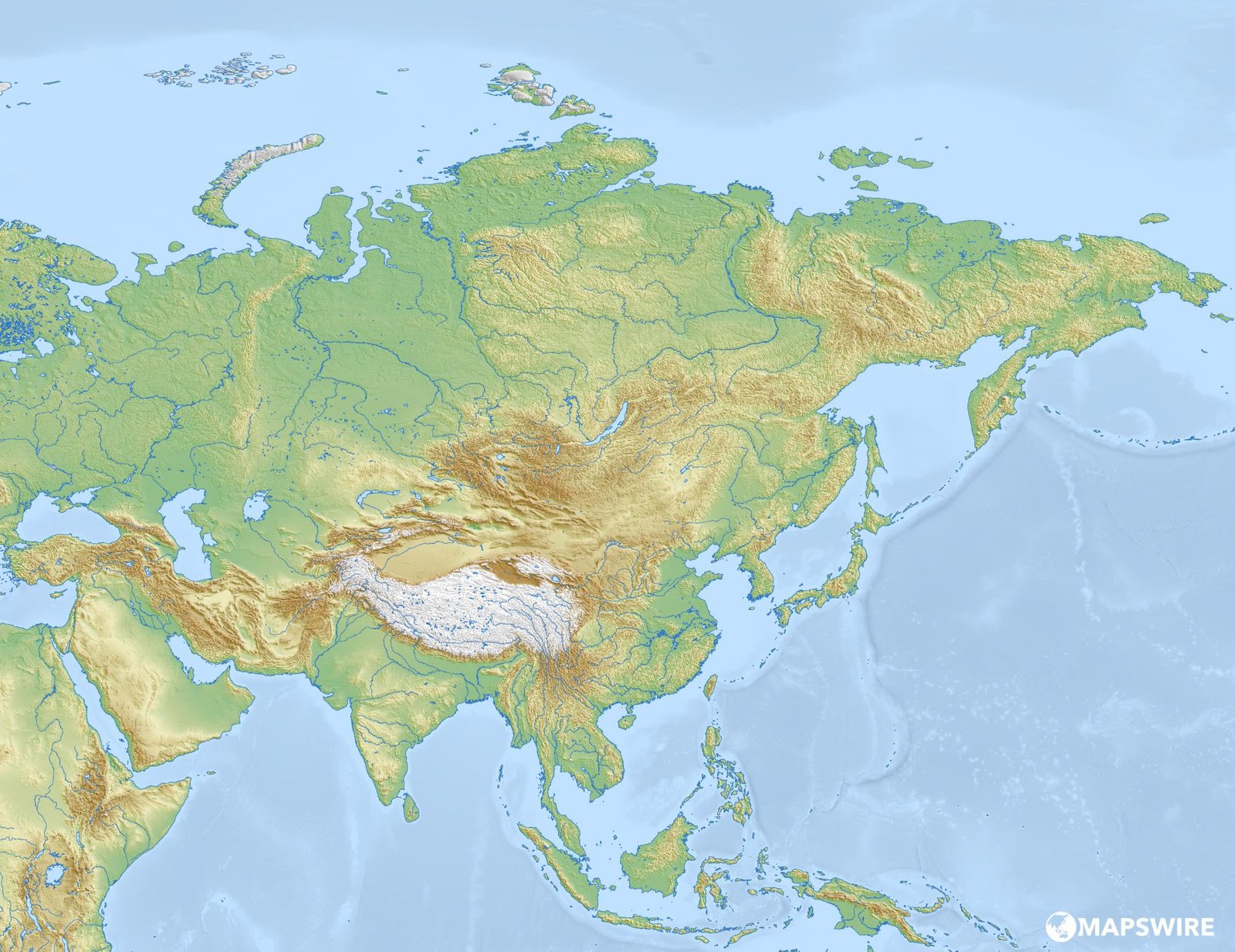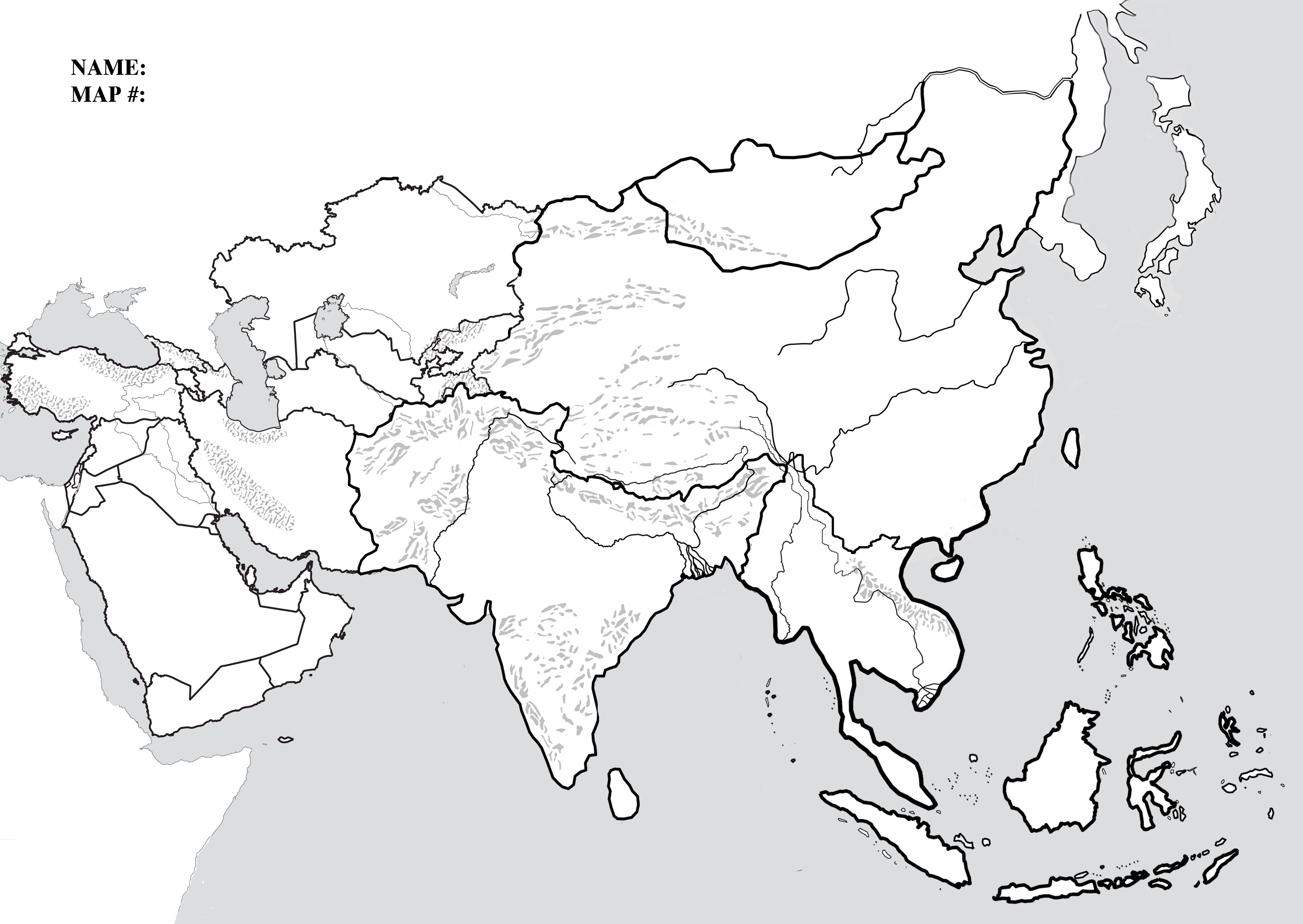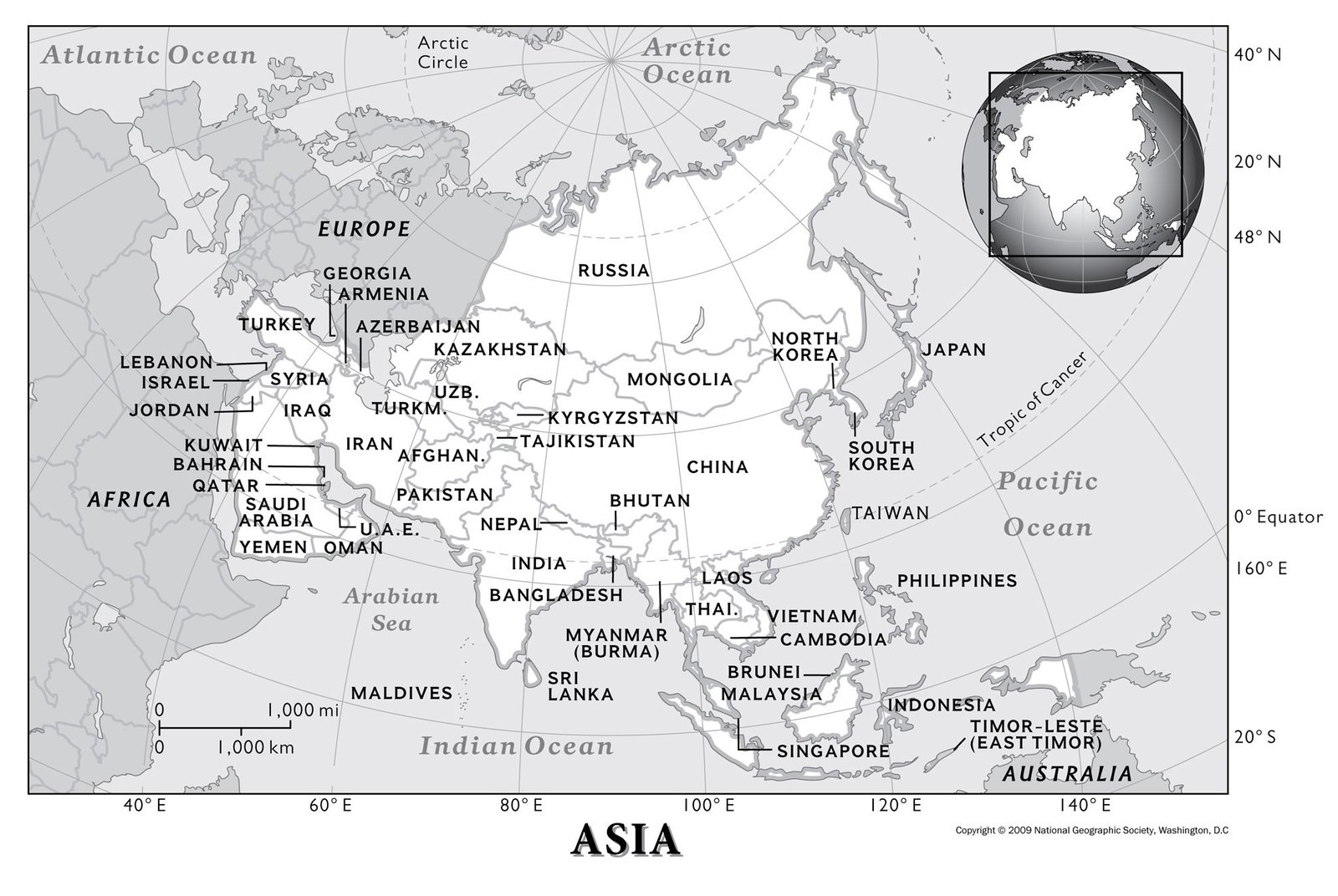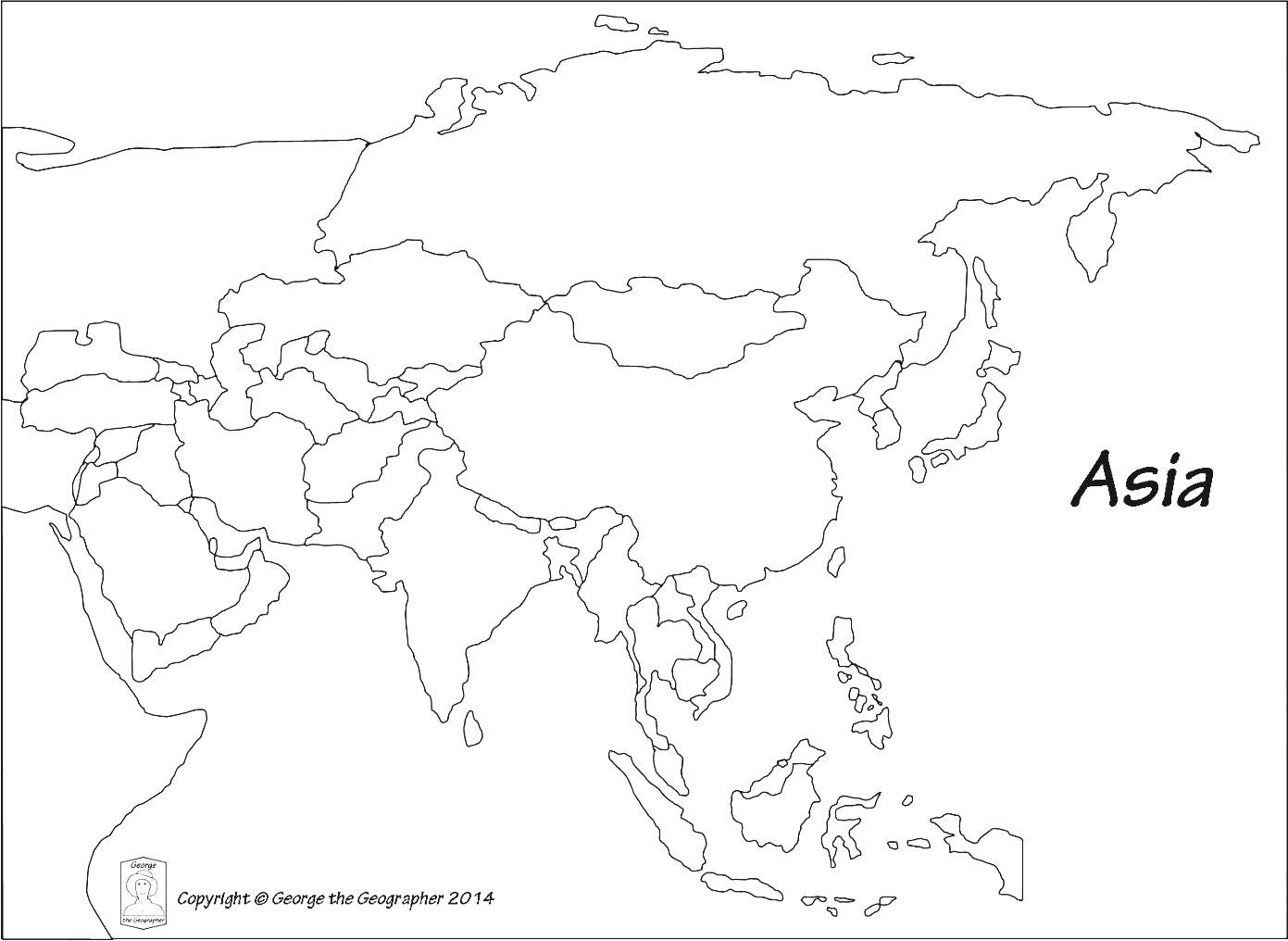4 Free Printable Physical Map of Asia in Detailed
The World consists of several continents, and those continents are divided into several countries. One of the continents is Asia. It is the largest continent and the most populous continent in the world. The reason is that both China and India are Asian countries and have a population above 1.2 billion each. You can also check out the printable world map.
Table of Contents
Blank Physical Map of Asia

The blank physical map of Asia has been provided here free of charge. You can download this if your teacher has asked you to bring the map to school. This blank physical map is handy. As it is provided here for free, you can download and print as much as possible. You can also use it to access your knowledge of the countries. Even if you can locate a country and its correct location on the map, the map would also help you to understand it more deeply.

Asia’s Physical Geography
Asia is the largest continent on the planet. Mountain systems, plateaus, plains, steppes, deserts, freshwater environments, and saltwater ecosystems are the five major physical zones. Asia is the world’s largest continent, containing nearly 30% of the planet’s land area. With almost 60% of the world’s population, it is also the most populous continent.
The eastern half of the Eurasian supercontinent is occupied by Asia, while Europe occupies the western half. The border between the two continents is a point of contention. Most geographers, on the other hand, consider Asia’s western edge to be an indirect line that runs via the Ural Mountains, the Caucasus Mountains, and the Caspian and Black Seas. The Arctic, Pacific, and Indian Oceans surround Asia. The physical geography, environment, and resources of Asia, as well as its human geography, can all be studied separately. Mountain systems, plateaus, plains, steppes, and deserts; freshwater environments; and saltwater ecosystems are the five major physical regions of Asia.
Physical Map of Asia PDF

The physical map of Asia is downloadable in PDF format free of charge; the PDF format is easy to download and store. This format keeps the image intact and does not allows the picture to be thrust out. The PDF format needs special software to support its design; make sure that you have the software to run the PDF file.
Plains, Steppes, and Deserts in Asia
The West Siberian Plain, located in central Russia, is one of the world’s largest continuous flatland expanses. It stretches around 2,400 kilometers (1,500 miles) north to south and 1,900 kilometers west to east (1,200 miles). The plain features some of the world’s most extensive wetlands and flood plains, with more than half of its surface below 100 meters (330 feet) above sea level.
The mountain forest-steppe, the arid steppe, and the desert steppe are the three different steppe zones in Mongolia. These zones run from the country’s mountainous north to the Gobi Desert on the country’s southern border with China.
The Rub’ al Khali desert, the world’s most immense sand sea, stretches through Saudi Arabia, Oman, the United Arab Emirates, and Yemen, covering an area larger than France. Even though it is 15 times smaller, it stores nearly half as much sand as Africa’s Sahara desert. Except for the Bedouin tribes who live on its outskirts, the desert is known as the Empty Quarter because it is virtually uninhabitable to humans.
Asia Outline Map With Countries

We are giving this format or template out to you with the outline map of the countries free of charge. There are nearly around 48 countries in Asia. It is the biggest continent globally and the most populous country globally. With the pace at which India and China are progressing, the future is in Asia. So, it is needed to know the countries of Asia.
Asia Physical Map Quiz
The Pacific Ocean bounds east Asia, the Indian Ocean bounds South Asia, and the Arctic Ocean determines north Asia. This continent is so large that three oceans have surrounded it. Asia is also home to the oldest civilizations in the world. The then cultures dominated the world. China and India are the major economic powers and the fastest growing economy globally. The geographic region of Asia is too diverse; it takes much time to study Asia.
Mountain Systems
The Himalayas mountains separate the Indian subcontinent from the rest of Asia by around 2,500 kilometers (1,550 miles). The Himalayas were formed when the Indian subcontinent collided with the Eurasian continent about 50 million to 55 million years ago. The Indian subcontinent continues to smash into Asia, and the Himalayas are expanding at around 5 centimeters (2 inches) per year.
The Himalayas occupy about 612,000 square kilometers (236,000 square miles), passing across northern India and forming most of Nepal’s and Bhutan’s terrain. Because the Himalayas are so enormous, they are divided into three mountain belts. The Great Himalayas, in the far north, have the most significant average height at 6,096 meters (20,000 feet). The belt is home to nine of the world’s tallest peaks, over 7,925 meters (26,000 feet). Mount Everest, the world’s tallest mountain peak at 8,849 meters, is located within this belt (29,032 feet).
The Tien Shan mountain range, which straddles the boundary between Kyrgyzstan and China, runs for over 2,400 kilometers (1,500 miles). In Chinese, Tien Shan means “Celestial Mountains.” Victory Peak, at 7,439 meters (24,406 feet), and Khan Tängiri Peak, at 6,995 meters (24,406 feet), are the two highest summits in the Tien Shan (22,949 feet). Glaciers cover more than 10,100 square kilometers (3,900 square miles) in Tien Shan. Engil’chek Glacier, which is around 60 kilometers (37 miles) long, is the largest.
The Ural Mountains run from Russia to Kazakhstan in an indirect north-south line for about 2,500 kilometers (1,550 miles). At 250 million to 300 million years old, the Ural Mountains are among the most senior. These have been an erosion of the mountains over millions of years, and their average elevation now is between 914 and 1,220 meters (3,000 to 4,000 feet). Mount Narodnaya, at 1,895 meters, is the highest point in the area (6,217 feet).
Many plateaus, or areas of relatively flat high land, can be found in Asia. The Iranian plateau, which spans most Iran, Afghanistan, and Pakistan, encompasses more than 3.6 million square kilometers (1.4 million square miles). The table is not entirely flat, and there are some high mountains and low river basins to be found. Damavand, at 5,610 meters, is the highest mountain summit (18,410 feet). The Dasht-e Kavir and the Dasht-e Lut are two huge deserts on the plateau. The Deccan Plateau encompasses the majority of India’s southern region. The average elevation of the table is around 600 meters (2,000 feet). Three mountain ranges surround it: the Satpura Range in the north, the Eastern and Western Ghats on either side and the Satpura Range in the north. The plateau and its major rivers, the Godavari and Krishna, gently slope down to the Eastern Ghats and the Bay of Bengal.
The Tibetan Plateau is the world’s largest and highest landmass in human history. The plateau dubbed the “Rooftop of the World” spans an area roughly half the size of the contiguous United States and rises to approximately 5,000 meters (16,400 feet) above sea level. Because of its massive number of glaciers, the Tibetan Plateau is vital to the global water cycle. Outside of the poles, these glaciers contain the most ice. These glaciers feed Asia’s main rivers with ice and snow. The rivers supplied by the plateau’s glaciers serve around 2 billion people.
Freshwater
Lake Baikal, in southern Russia, is the world’s deepest lake, with a depth of 1,620 meters (5,315 feet). The lake is the world’s largest reservoir, with 20% of the world’s unfrozen freshwater. At 25 million years old, it is also the world’s oldest lake.
The Yangtze River is Asia’s longest and the world’s third longest river (behind the Amazon of South America and the Nile of Africa). The Yangtze River flows east from the Tibetan Plateau glaciers to the East China Sea, covering a distance of 6,300 kilometers (3,915 miles). The Yangtze, also known as China’s lifeblood, drains one-fifth of the country’s land area, houses one-third of its population, and contributes to China’s economy.
The Tigris and Euphrates rivers rise in eastern Turkey’s highlands and flow through Syria and Iraq before uniting near Qurna, Iraq, and emptying into the Persian Gulf. Mesopotamia, the territory between the two rivers, was the birthplace of the world’s first civilizations, including Sumer and the Akkadian Empire. Increased agricultural and industrial use has put the Tigris-Euphrates river system in jeopardy today. Desertification and rising salt levels in the soil have resulted from these forces, wreaking havoc on local watershed habitats.
Saltwater
The Persian Gulf is almost 234,000 square kilometers (90,000 square miles). Iran, Oman, the United Arab Emirates, Saudi Arabia, Qatar, Bahrain, Kuwait, and Iraq are its neighbors. Because of the rapid evaporation rate, the gulf is shallow and exceedingly salty. The bottom beneath the Persian Gulf is thought to have half of the world’s oil reserves. The countries bordering the Gulf have had a lot of disagreements over this valuable resource.
Between the Russian mainland and the Kamchatka Peninsula, the Sea of Okhotsk comprises 1.5 million square kilometers (611,000 square miles). Winter navigation is nearly impossible due to extensive ice floes. The Bay of Bengal is the world’s largest bay, covering almost 2.2 million square kilometers (839,000 square miles) and forming the border between Bangladesh, India, Sri Lanka, and Burma. The bay receives supply from several big rivers, notably the Ganges and the Brahmaputra. The Bay of Bengal’s brackish marshes, generated by the Ganges-Brahmaputra, is the world’s largest delta.
Terrestrial Flora and Fauna
China is known as the “Mother of Gardens” by botanists. It boasts more flowering plant species than the combined populations of North and South America. Many flowers can adapt to climates worldwide since China has such varied terrain, from the arid Gobi Desert to the lush rain forests of Yunnan Province. Many familiar flowers, such as roses and peonies, are thought to have originated in northern China. Fruit trees like peaches and oranges are likely to have developed in China. The dawn redwood, the only redwood tree found outside of North America, is also present in China.
Asia’s diverse physical and cultural landscape has influenced its animal domestication Yaks are giant cattle-like animals with a thick fiber coat and the ability to thrive at high altitudes where oxygen is scarce. Yaks’ coats are a source of warm, tough fabric and are being utilized for transportation and pulling ploughs. Yak milk is used to make butter and cheese.
The two-humped Bactrian camel is the traditional beast of burden on the Mongolian steppe. In the wild, Bactrian camels are critically endangered. The animal uses the nutrient-rich fat stored in the camel’s humps in times of drought, heat, or frost. Because of its size and ability to adapt to adversity, it is an excellent pack animal. Over vast distances, Bactrians can outrun horses. These camels were valuable in caravans along the Silk Road, the mythical trading route connecting eastern Asia with India and the Middle East.
Aquatic Flora and Fauna
Asia’s freshwater and marine ecosystems are rich in biodiversity. Lake Baikal is a unique ecological habitat due to its age and isolation. Aquatic life has evolved largely unaffected for millions of years, resulting in a diverse range of flora and animals. Because of its relevance to evolutionary science, the lake is also known as the “Galápagos of Russia.” It has 1,340 animal species and 570 plant species.
Hundreds of species present in Lake Baikal are endemic, meaning you can only find them there. The Baikal seal, for example, is one of the world’s few freshwater seal species. Baikal seals eat Baikal oil fish and omul as their primary food sources. Both fish are related to salmon and provide fisheries for the lake’s residents.
The Bay of Bengal is one of the world’s largest tropical marine ecosystems, located in the Indian Ocean. Hundreds of marine mammals live in the bay, including bottlenose dolphins, spinner dolphins, spotted dolphins, and Bryde’s dolphins.
You may also like

4 Free Political Map of Asia with countries in PDF
March 10, 2022

4 Free Labeled Asia River Map In PDF
March 22, 2021

Download Free Detailed Map of Asia Continent
July 24, 2018
1 Comment
Click here to post a comment
Recent Posts
- Utah Railroad Map
- Printable Map of Utah
- Utah Outline Map
- Utah County Map
- Utah Rivers Map





